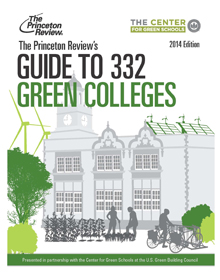W&M among country’s 'greenest' colleges
William & Mary is among the most environmentally responsible colleges in the country, according to a report published today by The Princeton Review.
The university’s sustainability efforts are profiled in the fifth annual edition of “The Princeton Review’s Guide to 332 Green Colleges” which can be downloaded for free online. The Princeton Review created the guide in partnership with the Center for Green Schools at the U.S. Green Building Council. W&M has been included in the guide every year since its inception.
 “We are very pleased to be included, once again, in the Princeton Review’s Guide to the greenest colleges,” said Chancellor Professor of Law Lynda Butler, who co-chairs the W&M Committee on Sustainability with Professor Emeritus of Marine Science Dennis Taylor. “Sustainability remains a core value and top strategic initiative of the College. It is gratifying to see our efforts recognized.”
“We are very pleased to be included, once again, in the Princeton Review’s Guide to the greenest colleges,” said Chancellor Professor of Law Lynda Butler, who co-chairs the W&M Committee on Sustainability with Professor Emeritus of Marine Science Dennis Taylor. “Sustainability remains a core value and top strategic initiative of the College. It is gratifying to see our efforts recognized.”
The institutions included in the guide were selected based on a 2013 survey of college administrators, which asked about course offerings, campus infrastructure, activities and career preparation. Based on that survey, 832 institutions received a "green rating," ranging from 60 to 99. The 332 schools included in the new guide received scores of 83 or above. William & Mary has a green rating of 88.
The guide does not rank the 332 schools, but it does include profiles on the institutions. The profiles highlight each college’s sustainability initiatives, and a "Green Facts" sidebar reports on a wide range of topics from the school's use of renewable energy sources, recycling and conservation programs to the availability of environmental studies and career guidance for green jobs.
In the William & Mary profile, the guide highlights the ongoing efforts of the W&M Committee on Sustainability and the projects supported by the Student Green Fee. The guide also highlights the connection between student research and institutional initiatives, such as a project to design and test solar cells.
“William & Mary is entirely transparent about its sustainability efforts (not surprising when it has so much to brag about),” the profile says.
The university’s Student Environmental Action Coalition, the Eco-House and the Sharpe Community Scholars Program also get a nod in the profile for their green-roof test plots, and the dining services team is also lauded for hiring student interns to coordinate sustainable food and composting initiatives. W&M’s LEED-certified buildings – including the Mason School of Business’ Miller Hall – are also recognized in the profile.
"We are pleased to recommend William & Mary to the many students seeking colleges that practice and promote environmentally-responsible choices and practices," said Rob Franek, senior vice president and publisher of The Princeton Review.
Franek noted his company's recent survey findings indicate significant interest among college applicants in attending "green" colleges.
"Among 10,116 college applicants who participated in our 2014 'College Hopes & Worries Survey,' 61 percent said having information about a school’s commitment to the environment would influence their decision to apply to or attend the school," he said.
The Princeton Review guide comes in the midst of William & Mary’s observance of Earth Week. The week’s events include opportunities to plant seedlings, watch the animated film Wall-E and discover local, organic teas. On Saturday, the week will culminate with an Earth Day celebration in the Sunken Garden with music, food, a petting zoo and more.














